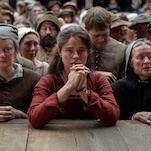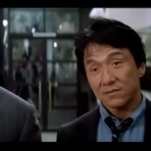In A Passage To India, Lean was blessed with
one of literature's greatest locations: the Barabar Caves (fictionalized as the
Marabar Caves), a half-natural/half-manmade wonder that hosts a moment of
sublime ambiguity. Judy Davis, playing a broad-minded Englishwoman, travels
east to meet her fiancé, a magistrate in India during the time of the British
Raj. There, she and her prospective mother-in-law Peggy Ashcroft are introduced
to Westernized doctor Victor Banerjee, who invites them on an expedition to the
Caves. But during their visit, Davis is overwhelmed by the heat and sensuality
of her environs, and… something happens. Forster never specifies what that
"something" is, and neither does Lean, but when Davis flees the caves, looking
disheveled, Banerjee is accused of rape, and the subsequent trial galvanizes
India's budding independence movement.
Forster's novel is a
sophisticated piece of political analysis, about how prejudices seep through in
spite of people's best efforts to beat them back. Lean's film is about that
too, but he literalizes a lot of the themes of the book, letting some of his
own prejudices show. From Banerjee's intentionally grating performance to
Davis' swooning at the sight of erotic statues and chattering monkeys, Lean
emphasizes the gulf between the earthy and the civilized, and though he's
critical of the British, it's still clear which side he understands better. Yet
in some ways, it's Lean's old-world sensibility that makes A Passage To
India
effective. While it isn't as brilliant as his The Bridge On The River Kwai or Lawrence Of Arabia, Lean's final film is
just as meticulously designed, because more than any other filmmaker of his
era, he understood how the right hat could say as much about a character
—and a society—as any line of dialogue.
Key features: A thorough commentary by
producer Richard Goodwin, plus revealing featurettes.








































